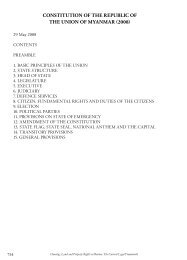Myanmar at the HLP Crossroads: - Displacement Solutions
Myanmar at the HLP Crossroads: - Displacement Solutions
Myanmar at the HLP Crossroads: - Displacement Solutions
Create successful ePaper yourself
Turn your PDF publications into a flip-book with our unique Google optimized e-Paper software.
33<strong>Myanmar</strong> <strong>at</strong> <strong>the</strong> <strong>HLP</strong> <strong>Crossroads</strong>interest. In terms of <strong>HLP</strong> rights, <strong>the</strong> 1974 Constitution reiter<strong>at</strong>es th<strong>at</strong> <strong>the</strong> St<strong>at</strong>e is <strong>the</strong> ultim<strong>at</strong>e owner of all n<strong>at</strong>uralresources and also of land; and th<strong>at</strong> it shall develop, extract, exploit and utilize <strong>the</strong> n<strong>at</strong>ural resources. The Constitutionrejected <strong>the</strong> economic rights th<strong>at</strong> had been protected in <strong>the</strong> 1947 Constitution. Notably, <strong>the</strong> Constitutiondoes not stipul<strong>at</strong>e rights to compens<strong>at</strong>ion for expropri<strong>at</strong>ion of priv<strong>at</strong>e property, thus establishing a legal frameworkleading inevitably to homelessness and landlessness.Article 22 of <strong>the</strong> Constitution ensures th<strong>at</strong> all citizens shall “be equal before <strong>the</strong> law, regardless of race, religion,st<strong>at</strong>us, or sex”, “enjoy equal opportunities” and have “<strong>the</strong> right to inherit according to law”. Article 160 protects<strong>the</strong> privacy and security of home, property, correspondence and o<strong>the</strong>r communic<strong>at</strong>ions of citizens subject to<strong>the</strong> Constitution. Article 161 protects every citizen’s income, savings, property and residential buildings lawfullyearned and acquired.After <strong>the</strong> adoption of <strong>the</strong> new Constitution, <strong>HLP</strong> legisl<strong>at</strong>ive activity effectively ceased for <strong>the</strong> next quartercentury, with <strong>the</strong> exception of Notific<strong>at</strong>ion No. 4/78 (1978) which st<strong>at</strong>ed th<strong>at</strong> any failure to sow <strong>the</strong> allotted landwith <strong>the</strong> earmarked crop to obtain optimum results or failure to sell <strong>the</strong> full quota <strong>at</strong> <strong>the</strong> stipul<strong>at</strong>ed price duringa determined period would result in confisc<strong>at</strong>ion of <strong>the</strong> land. Presently such powers are entrusted to village andtownship administr<strong>at</strong>ion and <strong>the</strong> cultiv<strong>at</strong>ors are compelled to follow <strong>the</strong>ir dict<strong>at</strong>es without voicing any protest.This was followed nearly a decade l<strong>at</strong>er by <strong>the</strong> adoption of <strong>the</strong> Transfer of Immovable Property Restriction Act(1987). The Act provides for restrictions on <strong>the</strong> ability to sell or give away immovable property to foreigners orforeign owned companies. The Act provides th<strong>at</strong> in <strong>the</strong> case of a deceased, “totally departed” or deported foreigner,<strong>the</strong> concerned Ministry may allow inheritance according to <strong>the</strong> law or confisc<strong>at</strong>e <strong>the</strong> immovable property as St<strong>at</strong>eownedproperty. The Act provides for an exception for approved diplom<strong>at</strong>ic missions and UN organiz<strong>at</strong>ions.Overall, <strong>the</strong> multitude of laws adopted between 1850 and 1988 gener<strong>at</strong>ed <strong>the</strong> development of a complex array ofdifferent land classific<strong>at</strong>ions, which remains in place today. Understanding how land is alloc<strong>at</strong>ed and defined is vitalin determining <strong>the</strong> different types of rights th<strong>at</strong> are associ<strong>at</strong>ed to each of <strong>the</strong> eleven forms of land th<strong>at</strong> exist underBurmese law today. While we have not been able to access inform<strong>at</strong>ion as to <strong>the</strong> percentage of <strong>the</strong> total land massof Burma th<strong>at</strong> each type of land currently occupies, we do know th<strong>at</strong> eleven types of land exist under law. These are:1. Freehold land - This type of land is transferable, largely urban in n<strong>at</strong>ure and no land revenue taxes arerequired to be paid on it. Such land can only, in terms of law, be expropri<strong>at</strong>ed in <strong>the</strong> public interest, subject to<strong>the</strong> payment of compens<strong>at</strong>ion, in accordance with <strong>the</strong> Land Acquisition Act. When this Act is invoked, it is <strong>the</strong>responsibility of <strong>the</strong> General Administr<strong>at</strong>ion Department under <strong>the</strong> Ministry of Home Affairs to provide compens<strong>at</strong>ionin <strong>the</strong> form of cash, altern<strong>at</strong>ive land plots or in o<strong>the</strong>r forms.2. Grant land - This type of land is owned by <strong>the</strong> St<strong>at</strong>e which is leased on a long-term basis to citizens on 10,30 and 90 year terms. Grant land is transferable and lessees are required to pay land tax. In Rangoon, grant landis provided by <strong>the</strong> Yangon City Development Committee and in Mandalay by <strong>the</strong> Mandalay City DevelopmentCommittee.3. Agricultural land - This type of land is used for agricultural purposes and governed according to <strong>the</strong> terms of<strong>the</strong> Tenant Act (1963). After 1953 and <strong>the</strong> Land N<strong>at</strong>ionalis<strong>at</strong>ion Act, all agricultural land became St<strong>at</strong>e land. Atpresent, agricultural land is alloc<strong>at</strong>ed by Village Peace and Development Councils, bodies which are under <strong>the</strong>full control of <strong>the</strong> SPDC. Agricultural land is not transferable and <strong>the</strong> military retains <strong>the</strong> right to determine whichtypes of crops are grown on such land and to force <strong>the</strong> grower to sell <strong>the</strong> crop directly to <strong>the</strong> St<strong>at</strong>e. If such rulesare contravened, <strong>the</strong> military can re-possess <strong>the</strong> land in question based on <strong>at</strong> least six grounds, including failureto cultiv<strong>at</strong>e on <strong>the</strong> alloc<strong>at</strong>ed land without a good reason; sub-letting <strong>the</strong> land to o<strong>the</strong>rs; selling, mortgaging ortransferring <strong>the</strong> land to o<strong>the</strong>rs; ceasing to farm <strong>the</strong> land; failing to grow <strong>the</strong> stipul<strong>at</strong>ed type of crop or failure to sell<strong>the</strong> full quota of <strong>the</strong> stipul<strong>at</strong>ed crop within <strong>the</strong> price and time-frame set by <strong>the</strong> junta.4. Garden land - This type of land is similar to agricultural land but <strong>the</strong> types of crops grown on it often differ,and land revenues on garden land is far higher than on agricultural land. Garden land is not transferable.5. Grazing land - This type of land is used for grazing purposes and land revenues are not required.













